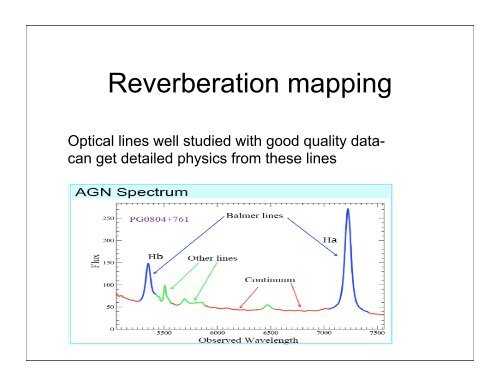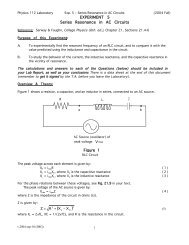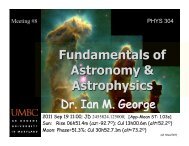Reverberation mapping
Reverberation mapping
Reverberation mapping
You also want an ePaper? Increase the reach of your titles
YUMPU automatically turns print PDFs into web optimized ePapers that Google loves.
<strong>Reverberation</strong> <strong>mapping</strong>Optical lines well studied with good quality datacanget detailed physics from these lines
<strong>Reverberation</strong> <strong>mapping</strong>Optical lines well studied with good quality datacanget detailed physics from these linesRecall:v =GM rR s= 2GMc 2V = c 2⎛⎝⎜rR s⎞⎠⎟− 1 2and for observed optical ‘broad lines’ the inferredvelocities suggest an origin r~1000 R s
<strong>Reverberation</strong> <strong>mapping</strong>v =GM rGetting r is very importantbecause if we can estimate r wecan get the central massSo, we need to be sure the simplistic estimation of r fromline widths is validAnother way of estimating r from optical lines is to tracktheir response to changes in the variable continuum
<strong>Reverberation</strong> <strong>mapping</strong>Lines are produced by illumination of the gas clouds bythe continuum- continuum drops, then the intensity ofline must dropThe change in line strength is delayed by the time it takesthe light to travel from the continuum region to the gascloud, so the line should ‘respond’ some time after thecontinuum changes
Light Crossing Time•Variations smeared out by light-crossing time over source•Observed timescales yield source size constraint R < c t
http://www.astronomy.ohio-state.edu/~peterson/AGN/
X-ray Observations of AGNWhat we can learn aboutthe inner regions of AGNusing X-ray data?
Recap: Black Holes that are switched on are“active”Measurements of gas &stellar kinematics showmost/all nucleated galaxiesharbor black hole at center(Kormendy & Richstone ‘95,Magorrian et al ‘98, Gebhardtet al 2000)BH mass scales withgalaxy bulge mass soformation linked, althoughunclear how. Many ofthese BHs “switched off”Peterson “An Introduction to Active Galactic Nuclei”Few % of galaxies - black hole is actively accreting material - releases large amount ofenergy over broad frequency band, from small region -nucleus - these powerful emitterscalled active galactic nuclei (AGN)
Recap: The Power behind AGNSimple arguments support that AGN must be powered by–Eddington limit requires selfgravity exceeds radiationpressure giving M > 10 6 M ¤–Accreting material has angularmomentum -forms accretiondisk that radiates asgravitational p.e. lost, only way toget enough luminosity from sucha small region–Accretion disk around a 10 6 –10 8 M ¤black hole emits thermalspectrum - peaks in UV band inagreement with observations
Luminosity required to hold a particle in balance between gravityand radiative pressureL edd:= 4πGcm pσ TM BH≈ 1.3x10 38 M BHM erg / sgpe U=-GM 2 /2r is released at a rateL ≈ dUdt= GM rL ≈ dUdtdmdt= GM r= GM Mrdmdt= GM MrL here is released g.p energy/sQuantification of that for accreting gas is -half of this released goes intoheating the gas, for accreting mass M, half of gpe goes into heating gas,half radiated away at a rate L diskL diskL = GM M2r= 2πr 2 σT 4
Copious production of X-RaysUV photons from innerdisk Inverse Comptonscatter off relativisticelectrons in coronaThermal Comptonization-> hard X-raysSome X-rays shine back onto disk producing a “reflection spectrum”Continuum + reflection pass thro’ ionized circumnuclear gas - thatimprints further absorption & emission features on observed spectrum
X-ray Line ProductionConsider X-rays illuminatingoptically-thick, cold acc n diskPhotoelectric absorption(energy dependent)photons are re-emitted viafluorescenceEmission lines & absorptionedges resultFe Kα most prominent due tocombination of abundance &fluorescence-yieldGeorge & Fabian ‘91
X-ray Line ProductionGeorge & Fabian ‘91, Reynolds 1996Ross & Fabian 2006Compton Scattering - hard photonsscatter with Compton recoilreducing scattered flux above 15keVLine energy (6.4-6.97keV) depends onionization
X-ray Absorption Line ProductionCompton-thin material(optically-thin to X-rays) produces narrowabsorption & emissionlines - detectiondepends on our view ofgas geometryKaspi et al 2002
Chandra/XMMSuzakuAbsorptionfrom outflow↓ThermalDiskEmission?Iron K LineX-rayContinuumComptonscatteringhump(Fabian, 2006, AN, 327, 943)
What are we hoping to LEARNfrom X-ray studies of AGN?Ultimately we hope to understand something fundamental:- physics in the strong gravity regime Fe Kα from disk- black hole accretion/fueling (and hence growth, evolution,structure formation) trace gas near BHHow do we get from X-ray data to the physics?
Profile distorted SR & GR- probe of inner disk/BHFe Kα/Reflection
Profile distorted SR & GR- probe of inner disk/BHFe Kα/Reflection
GR Effects on Spectral featuresProfile distorted SR & GR- probe of inner disk/BHAlso see GR blurring ofabsorption featuresLine energies, widths,strengths and variability canalso tell us about theaccretion flow and feedback(disk winds etc)Smeared absorber -Gierlinski & Done 2004
Fe Kα/ReflectionDistorted Fe Kα profilesapparently observed in ASCAdata for most nearby AGN(eg. Fabian et al 1994, Tanaka et al 1995)sample4 5 6 7 8(Nandra et al 1997)“Red wing”
MCG-6-30-15: Poster ChildTanaka et al. 1995, Wilms et al 2000 and many more…“Red wing”Energy (keV)Fe Kα… -but line variability, peak energydid not match expectations
What about X-ray spectral variabilityMkn 766 Miller et al 2007Ummm….but disk derived inclinations don’t match other indicatorsSpectral variability not as predictedBroad disk line does not vary correlated with continuum
Absorption or Reflection as the origin of theAGN continuum shape when dim?Ionized ReflectionSmeared Absorption?Ballantyne et al 2004, Ross & Fabian 2006Gierlinski & Done 2004
Seyfert Spectral Variability Behavior
Light bending?Suzaku lightcurveMiniutti & Fabian (2004) suggestcontinuum source height varies, whencont m produced close to disk gravitybends light onto accretion disk,reducing continuum flux whileenhancing reflection featuresLightBendingIron line does not respondto continuum
Ambiguity: - X-ray AbsorptionLarge columns (> 10 23 cm -2 ) ofhigh-ξ gas first suggested fromionized edges in Ginga data(Nandra & Pounds 1994)NGC 3516 Turner et al 2005Chandra/XMM confirmimportance of such gas bydetection of narrow absorptionlinesCan reduce implied broad redwing (Kinkhabwala 2003)…..NGC 3783To understand Fe K profiles thisgas needs to be accounted for…Reeves et al 2004
Ambiguity: - X-ray AbsorptionNGC 3516 Turner et al 2005NGC 3783Reeves et al 2004
Complex & Variable AbsorptionComponents log ξ~3.5 - 5, N H>> 10 23cm -2 -can we model all curvature withthese?Kallman et al 2004N H~ 3x 10 23 cm -2 , log ξ=2.25Counter claims: Young et al (2005)say cannot thus “explain away”diskline in MCG-6-30-15 strongfeatures ~6.5 keV, not observedHETG, Young et al 2005Counter-counter claims: L. Miller etal (2008) say MCG-6 explainedwithout recourse to blurring
How much evidence is there forabsorption mimicing ‘disklines’• Got to search for absorbing gas in acertain parameter range to get the rightcurvature
A highly ionized outflow in some Seyferts(Turner et al. 2008)Numerous absorption lines, strong (100 eV, EW) lines near 6.7, 6.97 keVrest frame, Fe XXV, XXVI 1s-2pN H>5x10 23 cm -2 v turb=3000 kms -1
More Evidence for ionized outflows:NGC 3516Fe XXVINeutralFe KαChandra/HEGFe XXV
Iron K-shell Absorption in Seyfert 1s.NGC 3783, XMM, Reeves et al. (2004)NGC 1365/XMM, (Risaliti et al. 2005)
Seyfert Spectral Variability Behavior
Occultation in MCG-6-30-15McKernan & Yaqoob 1998Occultation by optically-thick cloudexplains flux and spectral variabilityin target low state, including Feemission lineDeep dip is aneclipse event !
Partial Covering/Occultation, resurgence of anold ideaAlways an appealingalternative to diskreflection, to explaingeneral shapes of AGNspectra and big fluxvariations (e.g. Boller et al1997, 2002)Explains some Galacticblack holes (e.g. Dower,Bradt, Morgan 1982,Brandt et al 1996, Tanaka,Ueda and Boller 2003)Gierlinski & Done 2004 Turner et al 2007The idea resurfaced with a vengeance because of the complex absorbers revealed by new dataGrating spectroscopy points specifically to a wind origin for the gas
Outflows in AGN(Outflow Schematic; Elvis 2000)Outflows (in the form of warmabsorbers) are seen in the majority ofnearby AGN.Typically velocities ( from a few 100km/s to a 1000 km/s, which couldcarry a few solar masses per year (outto pc scales).In some higher luminosity AGN strongblue-shifted Fe K absorption featuresare seen above 7 keV - possible high voutflows at v~0.1cOutflows can carry significant KineticpowerCan provide feedback between BH/bulge mass in galaxy.
Summary• Large amounts of gas are seen in X-ray band and this gas mustexist close to black hole (illuminated by X-rays that come fromvery close to BH and X-ray spectral signatures vary fast,meaning they come from a very small region)• High velocities detected for X-ray absorbing/emitting gas• In principle can learn about effects very near BH, such aslooking for GR distortions of emission and absorption lineprofiles• Feedback from nucleus to the host galaxy can be studied bylooking at velocities in to /out from nucleus
















